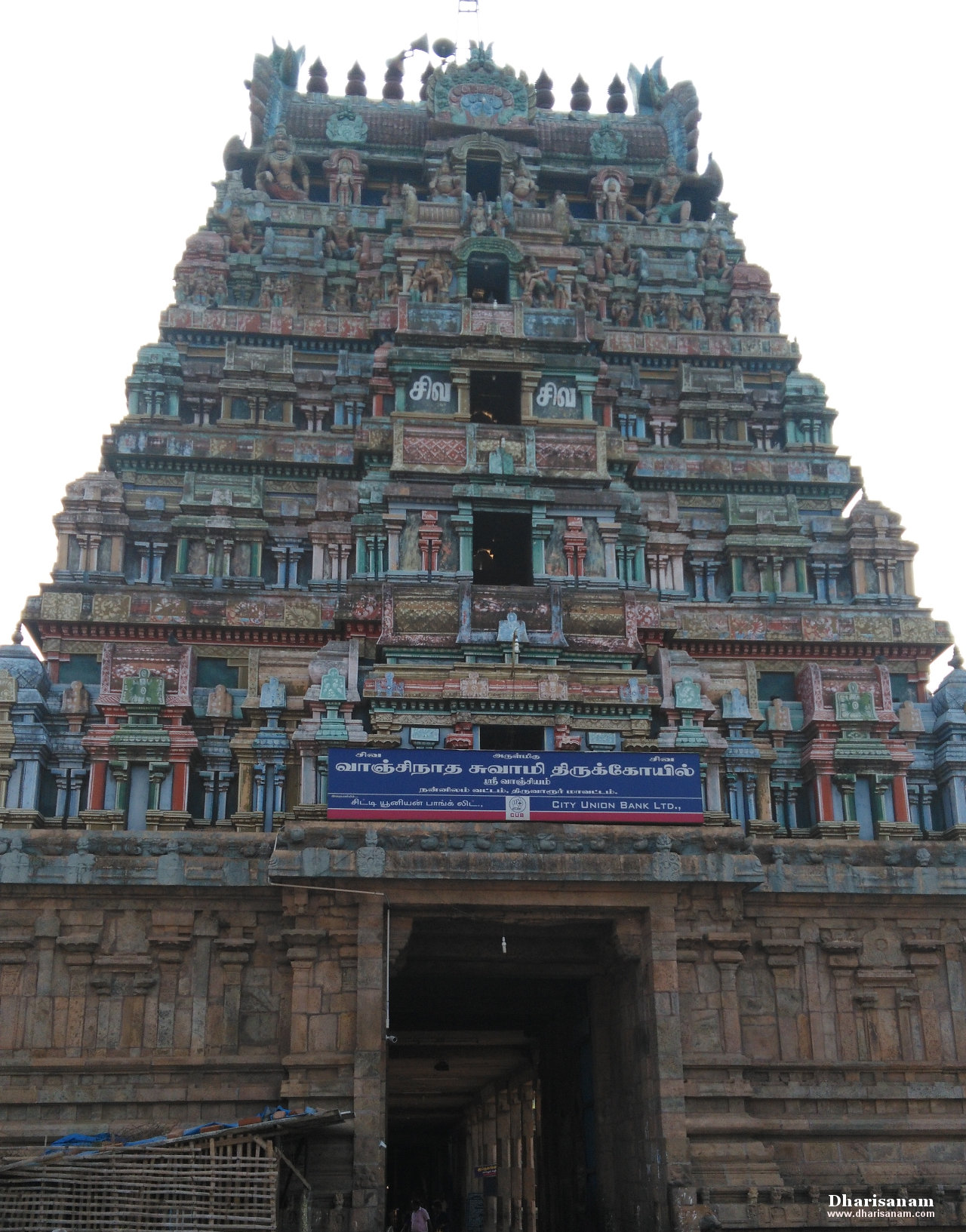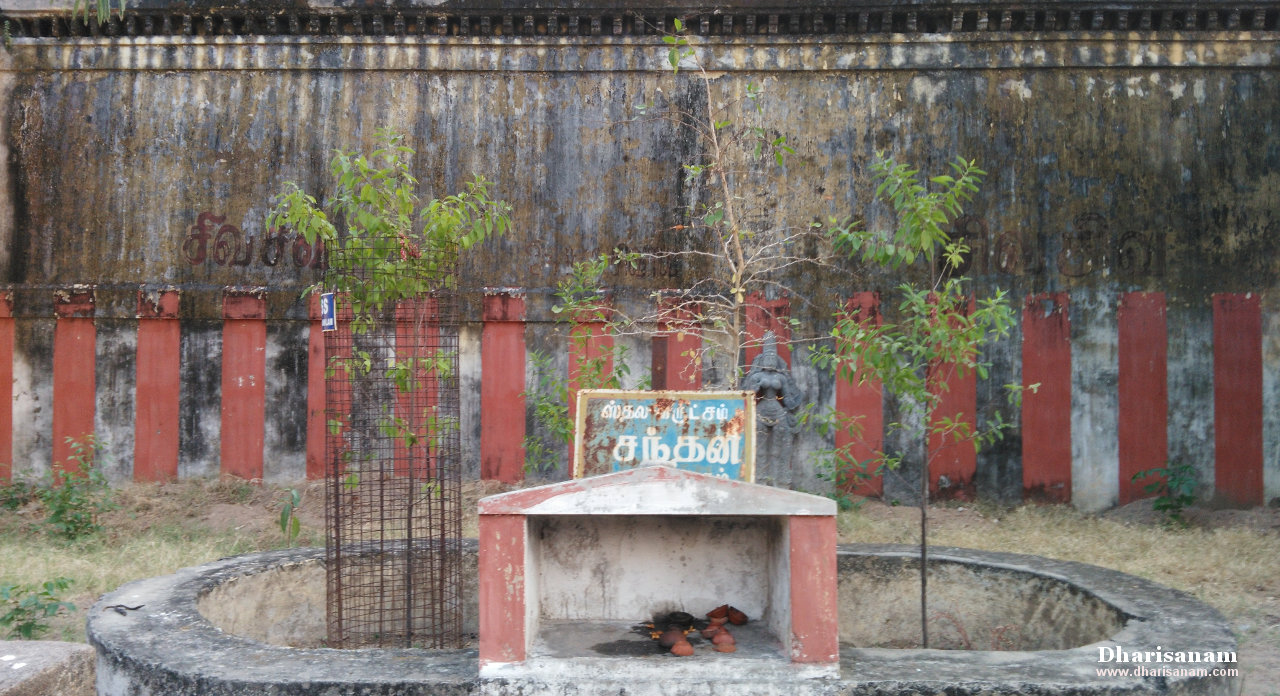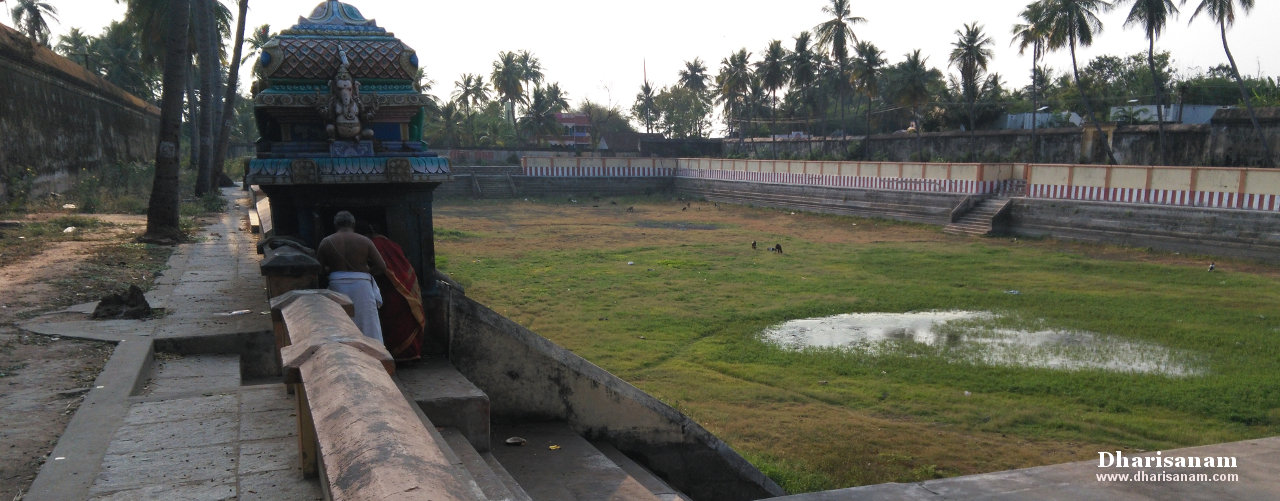Visited on: 1st April, 2018
Location
Thiru Vanchiyam (Sri Vanchiyam) is located at a distance of about 30 kms from Kumbakonam on the Kumbakonam - Natchiarkovil - Nannilam route. From Nannilam, it is about 6 kms and from Thiruvarur, it is about 17 kms.
Other Devara Paadal Petra Shiva Sthalams near this place are – Nannilam, Thiru Kondeecharam, Thiruveezhimizhalai, Serukudi, Thalaiyalangadu and Thiru Peruvelur.
General Information
| Moolavar | Sri Vaanchinathar, Sri Vanchi Lingeswarar |
| Ambal | Sri Mangalambikai, Sri Vazhavantha Nayaki, Sri Sugandha Kundalaambikai |
| Theertham (Holy water) | Gupta Ganga, Yama Theertham, Anandha Theertham, Deva Theertham, Lakshmi Theertham, Naga Theertham and Chakra Theertham |
| Sthala Vriksham (Sacred Tree) | Sandalwood tree |
| Pathigam (Hymn) rendered by | Saint Thirugnanasambanthar-1, Saint Thirunavukarasar (Appar)-1, Saint Sundaramurthy (Sundarar)-1 |
- This is one of the 276 Devara Paadal Petra Shiva Sthalams and 70th Shiva Sthalam on the Southern bank of the river Cauvery in Chozha Nadu (Thenkarai).
- Lord Shiva in this temple is a Swayambumurthi (self-manifested).
- This temple is famous for Lord Yama’s shrine.
- Devotees worship the lord here and seek his blessings for a long and prosperous life.
- This temple is famous as a Rahu-Ketu parihara Sthalam.
- This place is called as the “Mount Kailash on earth” (“Bhoologa Kailash”).
- This is one of a few Paadal petra sthalams where the “Nalvar” (the four saints - Saint Thirugnanasambanthar, Saint Thirunavukarasar (Appar), Saint Sundaramurthy (Sundarar) and Saint Manickavasagar had rendered their Pathigams.
- This east facing temple has 3 corridors and its main tower (Rajagopuram) has 5-tiers.
- The last consecration ceremony (Maha Kumbabishekam) took place on 10.04.1989.
History of the Temple
This is one of the six Shivasthalams on the banks of the river Cauvery which are considered to be very sacred and are equivalent to Kasi (Banaras). These are Thiruvengadu, Thiruvaiyaru, Chaayavanam, Mayiladuthurai, Thiruvidaimarudur and Thiruvanchiam (this temple).
According to Hindu mythology, at the end of every “Yuga”, there is a huge flood (deluge) that leads to the destruction of all living beings on the earth. This is called the “Pralayam”. It is believed that this place was not destroyed even at the end of the “Pralayam”.
It is believed that in each of the four Yugas the idol of Lord Shiva takes a different form. It is considered to be made out of gemstone (Rathinam) in Kretha Yuga, gold in Thretha Yuga, silver in Dvapara Yuga and granite in Kali Yuga.
There are 27 stone inscriptions in this temple which date back to the periods of the later Cholas, Pandiyas and Nayakkars. This temple was originally built by Chola King Rajarajan.
The historical names of this place are Vanchiyapathi, Santhanavanam, Thiruvaraiyur, Bhukailasam and Gandhaaranyam.
This temple is under the administrative control of the Hindu Religious and Charitable Endowments Department of Government of Tamil Nadu (HR&CE).



Legend
Lord Shiva is believed to have told Goddess Parvathi that he loves this place the most. She visited this place and decided to stay here. Hence, she is praised here as “Sri Vazhavantha Nayaki” (“vazhavantha” means “the one who came to stay” and “nayaki” means goddess in Tamil).
According to legend, due to some conflict between Goddess Sridevi and Boomadevi, Sridevi left Lord Mahavishnu. He then came to this place and worshipped Lord Shiva here to seek his blessing to be reunited with Goddess Sridevi. It is believed that Lord Shiva blessed him and reunited the couple. Due to the “Vaanchai” (“vaanchi” means affection in Tamil) this place gets the name Sri Vanchiyam.
Another legend associated with this place is that of Yama, the god of death. In Hindu mythology, Yama is believed to be the one who decides the afterlife for human beings based on their good or bad deeds. It is believed that he was once very worried about himself. He was under the impression that because of taking away many lives, he had accrued many sins. He felt that he was destined to go to hell after his death. He sought the advice of Lord Brahma for a solution to this problem. Lord Brahma asked Yama to go to earth and find out a place on the banks of the river Cauvery, where Sandal wood trees were in abundance. He asked him to perform penance there. He further advised Yama that Lord Shiva will take care of him.
Yama found this place (Sri Vanchiyam also known as “Gandhaaranyam”) to be the one that most suited his needs. He performed his penance here. Pleased with his penance, Lord Shiva blessed him with his dharisanam and told him that he had not done anything wrong while performing his duties. The lord asked Yama to build a temple for him which would also house a separate shrine for Yama. Lord Shiva also granted him the status of the guardian of this temple - “Kshetra Palakar”. The lord further informed that the people who visit this place should first offer prayers to Yama. Lord Shiva advised Yama to bless the devotees who come to worship him here with a long and peaceful life. Devotees would also be able to break free from the continuous cycle of life, death and rebirth. Yama built this temple and stayed here as the mount of Lord Shiva. Since this temple was built in a forest of sandalwood trees, it is called “Gandhaaranyam” (the fragrant forest).

Another legend associated with this temple is that of the river Ganges. She thought that since many people take a dip in her waters to cleanse themselves of their sins, she might have accrued all of those sins. She prayed to Lord Shiva for relief and the lord advised her to come to this place and take a dip in this temple’s tank. He also told her that he had asked Yama to do the same when he had come to him with the same problem. This tank is believed to have been created by Lord Shiva using his trident (“Trisul”). Ganga visited this place, took a dip in the tank and worshiped the lord. It is believed that she still stays in this temple’s tank. Hence this tank is called “Guptaganga”.
It is believed that Lord Mahavishnu, Brahma, Indran, Suryan, Agni, Devas, Saptharishis, Sage Athiri and Sage Parasarar have also worshiped the lord here.
Highlighting the significance of this temple, Sage Agasthiyar said that one will get salvation if one just thinks about this temple.
Deities in the temple
Other than the shrines of Lord Shiva and Goddess Parvathy, shrines and idols of Abhayankara Vinayakar, Murugan with his consorts, Mahalakshmi, Mahishasuramardhini standing beside her “Simha vahanam”, 63 Nayanmars, Kshethra Lingam, Sattanathar and Durgai can be seen in the corridors.
There are Shivalingams in the names of the lord at Thiruvengadu, Chayavanam, Mayiladuthurai, Thiruvidaimaruthur and Thiruvaiyaru. All these places are considered to be as sacred as Kasi.
Also, in the corridors are Theyu Lingam, Akasa Lingam, Dharmambal, Kailasanathar, Mahalakshmi, Chandramouleeswarar, Chandikeswarar and Sundareswarar with Meenakshi. It is surprising to see that Mahalakshmi’s elephant has four tusks.
In the “koshtam” (place surrounding the sanctum sanctorum), idols of Vinayakar, Dakshinamurthy, Lingothbavar, Brahma and Durgai can be seen.
There is no Navagraham here. However, there is a separate shrine for Saneeswarar.
A prominent feature of this temple is that Yama has a separate shrine. Devotees are advised to worship Yama first and then Lord Shiva. Chitragupta, the accountant of Yama, can also be seen in this shrine along with Yama.
There is a separate shrine for Lord Bhairavar in the inner corridor. He can be seen here sitting in a yogic posture. His mount (dog) is not seen along with him. This is a unique feature of this idol.
Next to the shrine of Bhairavar is the shrine for Rahu-Kethu, both carved from a single stone. This is another unique aspect of this temple.








Salient Features
In this temple, poojas are performed first to Yama and then to the other gods.
The procedure to worship in this temple is that one has to first take a dip in the Guptaganga, then worship Lord Vinayakar on the banks of this tank, then go to Yama’s shrine for worship and finally go to Lord Shiva’s shrine.
There is a “Yama Vahanam” (mount) in this temple over which the procession idol of Lord Shiva is taken during festivals.
Devotees believe that by worshiping Goddess Mahishasuramardhini here with 108 lotus flowers, they will be relieved from all kinds of “doshas”.
The Sthala Viruksham of this temple is Sandalwood tree. Here, Sandalwood leaves are used for pooja in place of Vilvam leaves.
It is believed that by reciting Saint Thirugnanasambanthar’s hymn, estranged couples will be reunited.
This temple is considered to be significant for its three important attributes – Moorthy, Sthalam and Theertham - glory of Lord, sacredness of the land and the auspicious temple tank.
Guptaganga Theertham is on the northern side of the outer corridor. According to the Sthala Puranam, a holy dip in this tank is equivalent to taking a dip in Varanasi, Rameswaram and the “Maha Maham tank” in Kumbakonam. Lord Vinayakar on the banks of the Guptaganga is to be worshiped after taking the holy dip.
It is believed that taking a dip in this Theertham would help devotees get salvation and will help them break away from the repetitive cycle of birth and re-birth.
There are three more Theerthams associated with this temple - Lakshmi Theeratham, Naga Theertham and Chakra Theertham. These were created by Goddess Lakshmi, Adhiseshan and Saint Chakrathazhwar respectively. A dip in Lakshmi Theertham on Fridays in the Tamil month of Aavani is believed to reunite a person with his estranged family. A dip in Naga Theertham on “Thiruvonam” star day in the Tamil month of Vaikasi is believed to liberate one from all the “Naga Doshas”. It is believed that by taking a dip in Chakra Theertham on “Ekadasi/Dvathasi” days in the Tamil month of Aavani, one is absolved of his “Brahmahathi dosham”.
In the first corridor, there is a relief depicting Lord Vinayakar. He is praised as “Vennai (butter) Pillaiyar”. People suffering from stomach ailments smear some butter on this Pillaiyar’s stomach with the hope that they will be cured.
Saint Arunagirinadhar has sang songs in praise of Lord Murugan of this temple in his revered Thirupugazh.
Another notable aspect in this temple is that routine poojas are carried out even if a death occurs in this village. Tradition mandates that the temple should remain closed if a death occurs in the village. However, this is not the case in this temple.
This temple is also open during the time of eclipse and special poojas are performed.
The sanctum sanctorum is in the form of semi-circular tank (“akazhi” in Tamil).
One must visit this temple to experience the grandeur and architectural beauty of the Chola and Nayakkar periods.
Greatness of this temple
This is a famous parihara sthalam for those afflicted with Rahu or Kethu dosham. By worshiping Rahu and Kethu here devotees are blessed with marriage boon, progeny and cure from nervous disorders.
It is believed that devotees will be relieved from the fear of death if they worship Lord Yama here.
Important Festivals
Some of the important festivals celebrated in this temple are –
10-day Aadi Pooram festival in the Tamil month of Aadi (July-Aug).
12-day “Kadai Gnayiru” festival in the Tamil month of Aippasi (Oct-Nov).
10-day Masi Maham festival in the Tamil month of Masi (Feb-Mar).
Other festivals celebrated here are -
Vinayakar Chaturthi and Aavani Moolam in the Tamil month of Aavani (Aug-Sept),
Navarathri in the Tamil month of Purattasi (Sept-Oct),
Skanda Shashti and Annabishekam in the Tamil month of Aippasi (Oct–Nov),
Thiru Karthikai in the Tamil month of Karthikai (Nov-Dec),
Theerthavari at Guptagangai on all Sundays in the Tamil month of Karthikai (Nov-Dec),
Thiruvadhirai in the Tamil month of Markazhi (Dec-Jan) and
Shivrathri in the Tamil month of Masi (Feb-Mar).
Pradosham is also observed regularly.
Temple Timings
From 06:00 AM to 12:00 Noon and from 03:30 PM to 08:30 PM.
Temple Address
Sri Vaanchinathaswamy Temple,
Sri Vanchiyam Post,
Nannilam Taluk,
Thiruvarur District,
Tamil Nadu – 610 107.
Tele: +91 4366 - 228305, 292305, 94424 03926, 94433 54302.






Pathigam (Hymn) with English transliteration and Tamil meaning.
Saint Thirugnanasambanthar visited this temple and sang this Pathigam.
Devotees visiting this temple should make it a practice to recite this Pathigam.
வன்னி கொன்றை மதமத்தம் எருக்கொடு கூவிளம்
பொன்னி யன்றசடை யிற்பொலி வித்தபு ராணனார்
தென்ன வென்றுவரி வண்டிசை செய்திரு வாஞ்சியம்
என்னை யாளுடை யானிட மாகவு கந்ததே.
“Vaṉṉi koṉtṟai mathamaththam erukkoṭu kūviḷam
poṉṉi yaṉtṟasaṭai yiṟpoli viththapu rāṇaṉār
theṉṉa veṉtṟuvari vaṇṭisai seythiru vāñchiyam
eṉṉai yāḷuṭai yāṉiṭa mākavu kanthathē”.
வன்னியிலை கொன்றைமலர் ஊமத்தம் மலர் வில்வம் ஆகியவற்றைப்
பொன்போன்ற தம் சடையில் சூடிய பழமையாளரும், என்னை அடிமையாகக் கொண்டவரும் ஆகிய சிவபிரான் தமது இருப்பிடமாகக் கொண்டு விரும்பிய ஊர், வரிவண்டுகள் ‘தென்ன’ என்ற ஒலிக் குறிப்போடு இசைபாடும் திருவாஞ்சியமாகும்.
கால காலர்கரி கானிடை மாநட மாடுவர்
மேலர் வேலைவிட முண்டிருள் கின்றமி டற்றினர்
மாலை கோலமதி மாடமன் னுந்திரு வாஞ்சியம்
ஞாலம் வந்துபணி யப்பொலி கோயில் நயந்ததே.
“Kāla kālarkari kāṉiṭai mānaṭa māṭuvar
mēlar vēlaiviṭa muṇṭiruḷ kiṉtṟami ṭatṟiṉar
mālai kōlamathi māṭamaṉ ṉunthiru vāñchiyam
gñālam vanthupaṇi yappoli kōyil nayanthathē”.
காலனுக்குக் காலர்; கரிந்த இடுகாட்டில் சிறந்த நடனம் புரிபவர்;
எப்பொருட்கும் எல்லா உயிர்கட்கும் மேலானவர்; கடலிடைத்தோன்றிய
நஞ்சினை உண்டு இருள்கின்ற கண்டத்தை உடையவர்; அச்சிவபிரான்,
மாலைக்காலத்தே தோன்றும் அழகிய மதி உச்சியில் பொருந்தும்
மாடவீடுகள் நிறைந்த திருவாஞ்சியத்தில் உள்ள அழகிய கோயிலை, உலகோர் வந்து தம்மைப் பணிந்து அருள் பெறுமாறு விரும்பி
விற்றிருந்தருளுகின்றார்.
மேவிலொன் றர்விரி வுற்ற இரண்டினர் மூன்றுமாய்
நாவின் நாலர்உட லஞ்சினர் ஆறர்ஏ ழோசையர்
தேவில் எட்டர்திரு வாஞ்சிய மேவிய செல்வனார்
பாவந் தீர்ப்பர்பழி போக்குவர் தம்அடி யார்கட்கே.
“Mēviloṉ tṟarviri vutṟa iraṇṭiṉar mūṉtṟumāy
nāviṉ nālar'uṭa lañchiṉar āṟar'ē zhōsaiyar
thēvil eṭṭarthiru vāñchiya mēviya selvaṉār
pāvan thīrpparpazhi pōkkuvar thamaṭi yārkaṭkē”.
விரும்பி வழிபடின் நீ நான் என்ற வேற்றுமை யின்றி அந்நியம் ஆவர்.
ஒன்றாய் அரும்பிய அவர் பலவாய் விரியுமிடத்து, சிவம் சத்தி என
இரண்டாவர். ஒன்றாய் வேறாய் உடனாய் மூன்றாவர். நாவினால் நான்கு
வேதங்களை அருளியவர். பரை ஆதி இச்சை ஞானம் கிரியை என்னும்
ஐவகைச் சத்தியாகிய திருவுருவை உடையவர். ஆறுகுணங்களை
உடையவர். ஏழு ஓசை வடிவினர். அட்டமூர்த்தங்களாய் விளங்குபவர்.
இத்தகையவராய்த் திருவாஞ்சியத்தில் எழுந்தருளியுள்ள செல்வனார் தம்
அடியவர்களின் பாவங்களைத் தீர்ப்பர். அவர் அடியவர்கட்கு வரும் பழியைப் போக்குபவர்.
சூல மேந்திவளர் கையினர் மெய்சுவண் டாகவே
சால நல்லபொடிப் பூசுவர் பேசுவர் மாமறை
சீல மேவுபுக ழாற்பெரு குந்திரு வாஞ்சியம்
ஆல முண்டஅடி கள்ளிட மாக அமர்ந்ததே.
“Chūla mēnthivaḷar kaiyiṉar meysuvaṇ ṭākavē
sāla nallapoṭip pūsuvar pēsuvar māmaṟai
sīla mēvupuka zhāṟperu kunthiru vāñchiyam
āla muṇṭa'aṭi kaḷḷiṭa māka amarnthathē”.
சூலம் ஏந்திய நீண்ட கையினை உடையவர்; தம் திருமேனிக்குப்
பொருத்தமாக நல்ல திருநீற்றை மிகுதியாகப் பூசுபவர்; சிறந்த வேத
வசனங்களைப் பேசுபவர். ஆலகாலம் உண்டருளிய அவ்விறைவர்,
ஒழுக்கத்தால் சிறந்தோர் வாழ்வதால் புகழ்பெற்ற திருவாஞ்சியத்தை
இடமாகக் கொண்டு அமர்ந்துள்ளார்.
கையி லங்குமறி யேந்துவர் காந்தளம் மெல்விரல்
தையல் பாகமுடை யார்அடை யார்புரஞ் செற்றவர்
செய்ய மேனிக்கரி யம்மிடற் றார்திரு வாஞ்சியத்
தையர் பாதமடை வார்க்கடை யாஅரு நோய்களே.
“Kaiyi laṅkumaṟi yēnthuvar kānthaḷam melviral
thaiyal pākamuṭai yār'aṭai yārpurañ chetṟavar
seyya mēṉikkari yam'miṭat ṟārthiru vāñchiyath
thaiyar pāthamaṭai vārkkaṭai yā'aru nōykaḷē”.
கையின்கண், விளங்கும் மான் கன்றை ஏந்தியவர்; காந்தள் இதழ் போன்ற
மெல்லிய விரல்களை உடைய பார்வதி தேவியைத் தமது பாகமாகக
கொண்டவர்; பகைவராகிய திரிபுரத்து அசுரரின் முப்புரங்களை அழித்தவர்; சிவந்த திருமேனியையும் கரிய மிடற்றையும் உடையவர்;
இத்தகையோராய்த் திருவாஞ்சியத்துள் எழுந்தருளிய தலைவராகிய
சிவபிரான் திருவடிகளை அடைபவர்களைப் போக்கற்கு அரிய நோய்கள்
எவையும் அடையா.
அரவம் பூண்பரணி யுஞ்சிலம் பார்க்க அகந்தொறும்
இரவில் நல்லபலி பேணுவர் நாணிலர் நாமமே
பரவு வார்வினை தீர்க்கநின் றார்திரு வாஞ்சியம்
மருவியேத் தமட மாதொடு நின்றஎம் மைந்தரே.
“Aravam pūṇparaṇi yuñchilam pārkka akanthoṟum
iravil nallapali pēṇuvar nāṇilar nāmamē
paravu vārviṉai thīrkkaniṉ tṟārthiru vāñchiyam
maruviyēth thamaṭa māthoṭu niṉtṟa'em maintharē”.
அரவை அணிகலனாகப் பூண்பவர்; காலில் அணியும் சிலம்பு ஆரவாரிக்க
வீடுகள் தோறும் நாணிலராய் இரவிற் சென்று நல்ல பலியைப் பெறுபவர்;
தம் திருப் பெயர்களைக் கூறிப் பரவுவார் வினைகளைத் தீர்க்கத்
திருவாஞ்சியத்துள் நாம் சென்று வழிபடுமாறு உமையம்மையாரோடு
எழுந்தருளியுள்ளார்.
விண்ணி லானபிறை சூடுவர் தாழ்ந்து விளங்கவே
கண்ணி னால்அநங் கன்னுட லம்பொடி யாக்கினார்
பண்ணி லானஇசை பாடல்மல் குந்திரு வாஞ்சியத்
தண்ண லார்தம்அடி போற்றவல் லார்க்கில்லை அல்லலே.
“Viṇṇi lāṉapiṟai sūṭuvar thāzhnthu viḷaṅkavē
kaṇṇi ṉālanaṅ kaṉṉuṭa lampoṭi yākkiṉār
paṇṇi lāṉa'isai pāṭalmal kunthiru vāñchiyath
thaṇṇa lārthamaṭi pōtṟaval lārkkillai allalē”.
வானகத்தே தோன்றிய பிறைமதியைத் தம் திருமுடியில் தங்கி விளங்குமாறு சூடியவர்; நெற்றிக் கண்ணால் மன்மதனின் உடலை நீறாக்கியவர். பண்களில் பொருந்திய இசையோடு பாடும் புகழ்பொருந்திய
திருவாஞ்சியத்துள் விளங்கும் அவ்வண்ணலாரின் திருவடியைப்
போற்றவல்லார்க்கு அல்லல் இல்லை.
மாட நீடுகொடி மன்னிய தென்னிலங் கைக்குமன்
வாடி யூடவரை யாலடர்த் தன்றருள் செய்தவர்
வேட வேடர்திரு வாஞ்சியம் மேவிய வேந்தரைப்
பாடநீ டுமனத் தார்வினை பற்றறுப் பார்களே.
“Māṭa nīṭukoṭi maṉṉiya theṉṉilaṅ kaikkumaṉ
vāṭi yūṭavarai yālaṭarth thaṉṟaruḷ seythavar
vēṭa vēṭarthiru vāñchiyam mēviya vēntharaip
pāṭanī ṭumaṉath thārviṉai patṟaṟup pārkaḷē”.
நீண்ட கொடிகள் நிலைத்துள்ள மாட வீடுகளைக் கொண்ட
தென்னிலங்கைக்கு அரசனாகிய இராவணன் வாடி வருந்தக் கயிலை
மலையால் அவனை அடர்த்துப்பின் அருள்செய்தவர்; அருச்சுனன் பொருட்டு வேட்டுவக் கோலம் தாங்கியவர். திருவாஞ்சியத்துள் எழுந்தருளிய வேந்தர். அவ்விறைவரைப்பாட எண்ணுவார், வினை, பற்று ஆகியன நீங்கப் பெறுவர்.
செடிகொள் நோயின்அடை யார்திறம் பார்செறு தீவினை
கடிய கூற்றமுங் கண்டக லும்புகல் தான்வரும்
நெடிய மாலோடயன் ஏத்தநின் றார்திரு வாஞ்சியத்
தடிகள் பாதமடைந் தாரடி யாரடி யார்கட்கே.
“Seṭikoḷ nōyiṉaṭai yārthiṟam pārseṟu thīviṉai
kaṭiya kūtṟamuṅ kaṇṭaka lumpukal thāṉvarum
neṭiya mālōṭayaṉ ēththaniṉ tṟārthiru vāñchiyath
thaṭikaḷ pāthamaṭain thāraṭi yāraṭi yārkaṭkē”.
நீண்டுயர்ந்த திருமாலும் பிரமனும் தம்மை வணங்குமாறு ஓங்கிநின்ற
திருவாஞ்சியத்து அடிகளாகிய சிவபிரான் திருவடிகளை அடைந்த
அடியவர்களின் திருவடிகளை அடைந்தவர்கள், துன்பம் தரும் நோய்களை
அடையார். துன்புறுத்தும் தீவினைகளால் மாறுபடார். கொடிய கூற்றுவனும்
அவர்களைக்கண்டு அஞ்சி அகல்வான். சிவகதி அவர்களைத் தேடி வரும்.
பிண்ட முண்டுதிரி வார்பிரி யுந்துவ ராடையார்
மிண்டர் மிண்டுமொழி மெய்யல பொய்யிலை யெம்மிறை
வண்டு கெண்டிமரு வும்பொழில் சூழ்திரு வாஞ்சியத்
தண்ட வாணன்அடி கைதொழு வார்க்கில்லை அல்லலே.
“Piṇṭa muṇṭuthiri vārpiri yunthuva rāṭaiyār
miṇṭar miṇṭumozhi meyyala poyyilai yem'miṟai
vaṇṭu keṇṭimaru vumpozhil chūzhthiru vāñchiyath
thaṇṭa vāṇaṉaṭi kaithozhu vārkkillai allalē”.
பிறர் திரட்டித்தந்த சோற்றை உண்டு திரியும் சமணரும், செந்நிற
ஆடையைப் போர்த்துழலும், அவரின் வேறுபட்ட புத்தரும் ஆகிய மிண்டர்கள் வலிந்துகூறும் உரைகள் மெய்யல்ல. பொய்யிலியாகிய எம் இறைவன் வண்டுகள் கிளறி உண்ணும் தேன் நிறைந்த மலர்களை உடைய பொழில் சூழ்ந்த திருவாஞ்சியத்துள் எழுந்தருளியுள்ளான். அண்டம் முழுவதும் வாழும் அவன் திருவடிகளைக் கைகளால் தொழுது வணங்குவார்க்கு அல்லல் இல்லை.
தென்றல்துன் றுபொழில் சென்றணை யுந்திரு வாஞ்சியத்
தென்று நின்றஇறை யானையு ணர்ந்தடி யேத்தலால்
நன்று காழிமறை ஞானசம் பந்தன செந்தமிழ்
ஒன்றுமுள் ளமுடை யாரடை வாருயர் வானமே.
“Theṉtṟalthuṉ tṟupozhil ceṉṟaṇai yunthiru vāñchiyath
theṉtṟu niṉtṟa'iṟai yāṉaiyu ṇarnthaṭi yēththalāl
naṉtṟu kāzhimaṟai gñāṉasam banthaṉa senthamizh
oṉtṟumuḷ ḷamuṭai yāraṭai vāruyar vāṉamē”.
தென்றல், பொழிலைப் பொருந்தி அதன் மணத்துடன் சென்று வீசும்
திருவாஞ்சியத்துள் என்றும் நீங்கா துறையும், இறைவனியல்பை உணர்ந்து
அவனடிகளை ஏத்தித் துதித்தலால், நன்மை தரும் காழிப்பதியுள்
மறைவல்லவனாய்த் தோன்றிய ஞானசம்பந்தனின் இச்செந்தமிழ்ப்
பாடல்களில் ஈடுபடும் மனம் உடையவர்கள், உயரிய வீடு பேற்றை அடைவர்.







